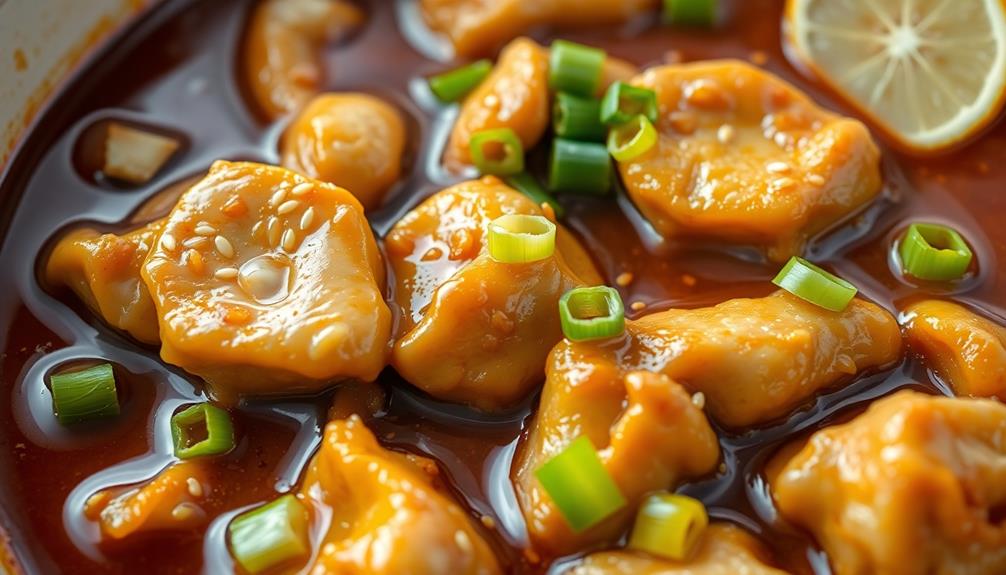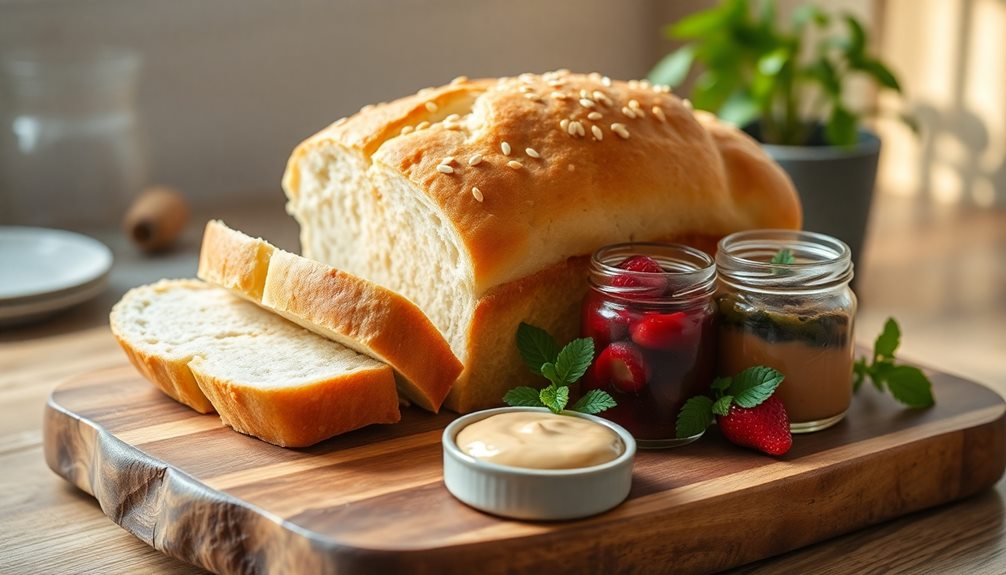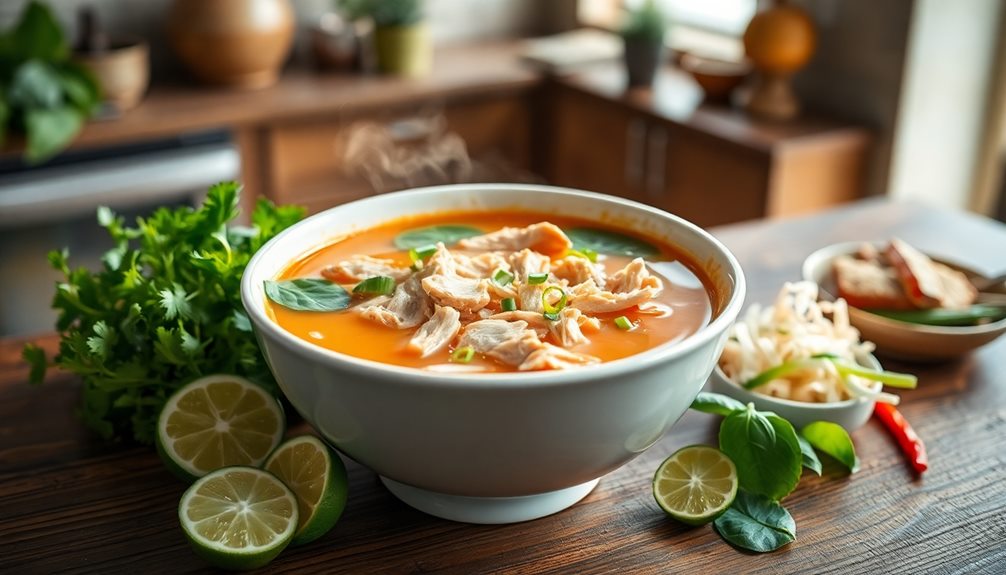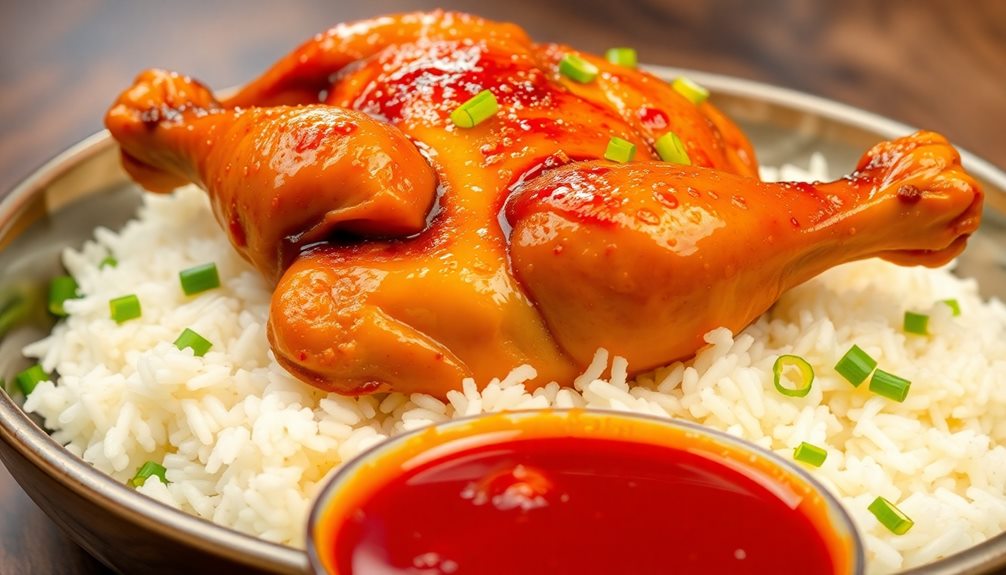Get ready to savor the vibrant flavors of Ga Kho Gung, a beloved Vietnamese braised chicken dish that's been delighting families for centuries! This comforting meal combines savory soy sauce, sweet brown sugar, and the warm, aromatic notes of fresh ginger, creating a rich, mouthwatering sauce that perfectly complements the tender, fall-off-the-bone chicken. With simple preparation and minimal active cooking time, Ga Kho Gung is ideal for weeknight dinners or special occasions. Dive in and experience the essence of Vietnamese cuisine – a perfect balance of flavors that's sure to satisfy your taste buds. Serve this delectable dish over a bed of steamed jasmine rice to soak up every drop of the luscious sauce, and don’t forget a side of fresh herbs or pickled vegetables to elevate the meal. While Ga Kho Gung embodies the soul of Vietnamese home cooking, it shares a similar attention to flavor harmony found in other Asian dishes, such as Korean Yukhoe steak tartare, where savory and sweet elements also play a central role. Both dishes highlight the beauty of simple yet bold seasonings, making them timeless favorites in their respective cuisines.
Key Takeaways
- Ga Kho Gung is a beloved Vietnamese dish with roots stretching back centuries, known for its savory soy sauce, sweet brown sugar, and aromatic ginger.
- The dish combines chicken, soy sauce, brown sugar, rice vinegar, garlic, and ginger to create a comforting and satisfying meal.
- The braising cooking method ensures the chicken is tender and juicy, with the flavors melding beautifully over the slow cooking process.
- Ga Kho Gung is a versatile dish that can be served with a variety of rice options and accompaniments, making it suitable for various occasions.
- The dish offers nutritional benefits, with the chicken providing a good source of protein and the ginger known for its anti-inflammatory properties.
History

When did Vietnamese braised chicken with ginger emerge as a beloved dish? This delightful recipe has roots that stretch back centuries, reflecting the rich culinary traditions of Vietnam.
Ga kho gung, as it's known in Vietnamese, likely originated as a simple, nourishing meal that farm families would prepare using locally-sourced ingredients.
Over time, the dish evolved, with regional variations emerging across Vietnam. In the north, the chicken might be simmered with daikon radish, while southern versions often incorporate palm sugar for a touch of sweetness.
Regardless of the specifics, ga kho gung has become a beloved comfort food, a warm hug on a chilly day.
Today, this dish remains a staple in Vietnamese homes and restaurants, a cherished part of the country's vibrant food culture.
Whether served for a family gathering or a festive celebration, ga kho gung continues to delight the senses and nourish the soul, one delicious bite at a time.
Recipe
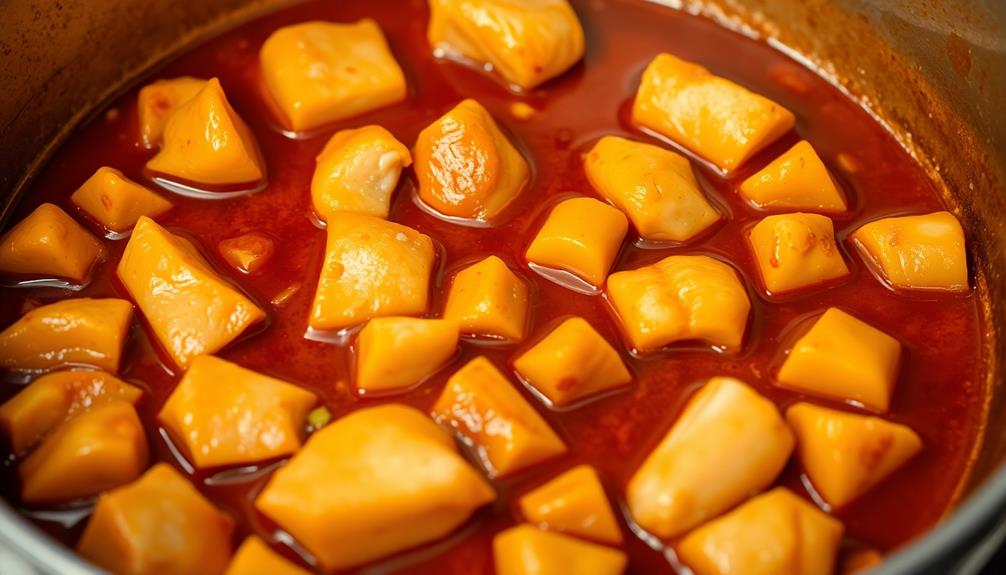
Vietnamese Braised Chicken With Ginger
Braised chicken is a comforting and flavorful dish that's a staple in Vietnamese cuisine. The combination of savory soy sauce, sweet brown sugar, and aromatic ginger creates a rich, caramelized sauce that perfectly complements the tender chicken. This dish is simple to prepare but delivers big on flavor, making it a great choice for a weeknight dinner or a special occasion.
The key to this dish is to let the chicken simmer slowly in the sauce, allowing the flavors to meld together and the meat to become fall-off-the-bone tender. The addition of ginger provides a subtle heat and earthiness that balances the sweetness of the sauce.
Ingredients:
- 1.5 lbs boneless, skinless chicken thighs, cut into bite-sized pieces
- 2 tbsp vegetable oil
- 1/4 cup soy sauce
- 1/4 cup brown sugar
- 2 tbsp rice vinegar
- 2 cloves garlic, minced
- 1 tbsp grated fresh ginger
- 1 tsp ground black pepper
- 2 green onions, sliced
- Cooked jasmine rice, for serving
In a large skillet or Dutch oven, heat the vegetable oil over medium-high heat. Add the chicken and cook, stirring occasionally, until lightly browned, about 5 minutes.
Add the soy sauce, brown sugar, rice vinegar, garlic, ginger, and black pepper. Stir to combine.
Bring the mixture to a simmer, then reduce the heat to low, cover, and let the chicken braise for 30-40 minutes, or until the chicken is cooked through and the sauce has thickened. Stir in the green onions during the last 5 minutes of cooking.
Serve the braised chicken immediately over steamed jasmine rice. The dish can be made ahead and reheated, as the flavors will only improve over time. Enjoy this comforting and flavorful Vietnamese dish!
Cooking Steps
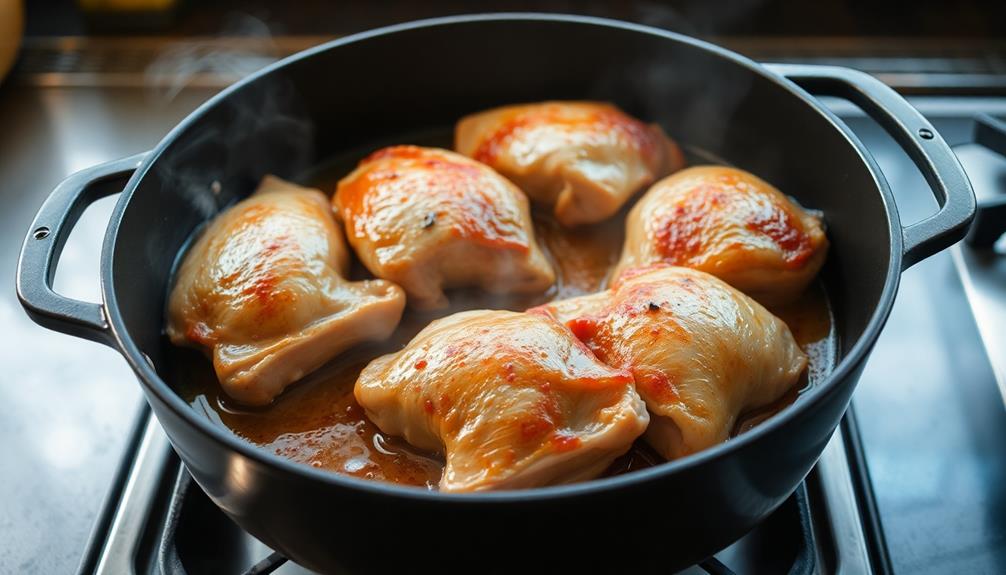
First, season the chicken with a sprinkle of salt and pepper.
Then, sear the chicken on both sides until it's nicely browned.
Next, add the chopped ginger, soy sauce, and chicken broth, and let it all simmer until the chicken is tender and flavorful.
Step 1. Season Chicken With Salt and Pepper
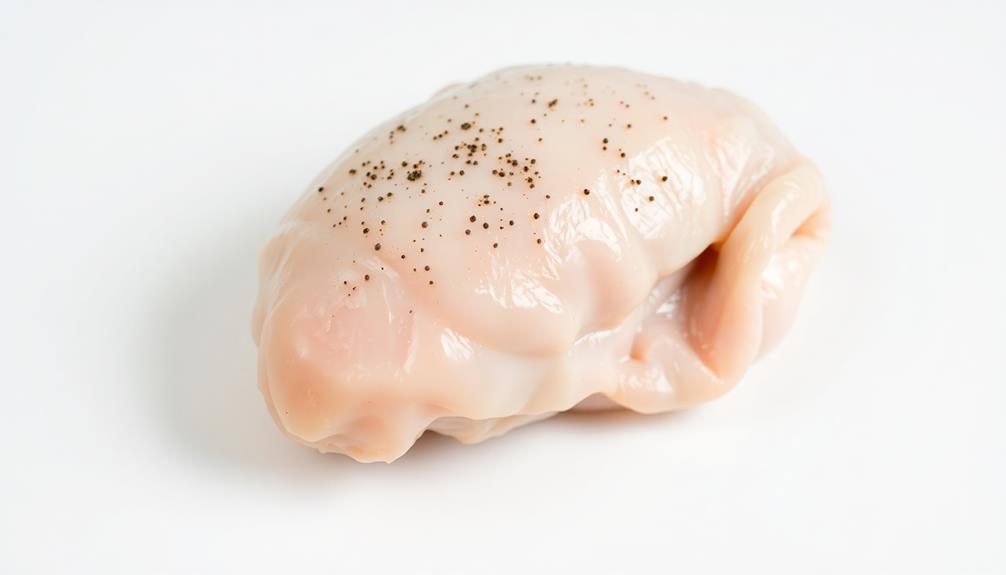
Seasoning the chicken with a simple salt-and-pepper blend lays the foundation for the dish's savory flavors.
Grab a pinch of salt and a few grinds of fresh black pepper, then sprinkle them evenly all over the chicken pieces. Use your fingers to gently rub the seasoning into the skin, making sure every nook and cranny is covered.
This simple step packs a punch of flavor that will permeate the meat as it braises. The salt enhances the natural juices, while the pepper adds a subtle warmth and complexity.
Don't be shy – you want a generous coating to really bring out the best in the chicken. Once the seasoning is evenly distributed, your chicken is ready for the next step in this Vietnamese braising journey.
Get excited, because the aroma of ginger, garlic, and soy is about to fill your kitchen!
Step 2. Sear Chicken on Both Sides
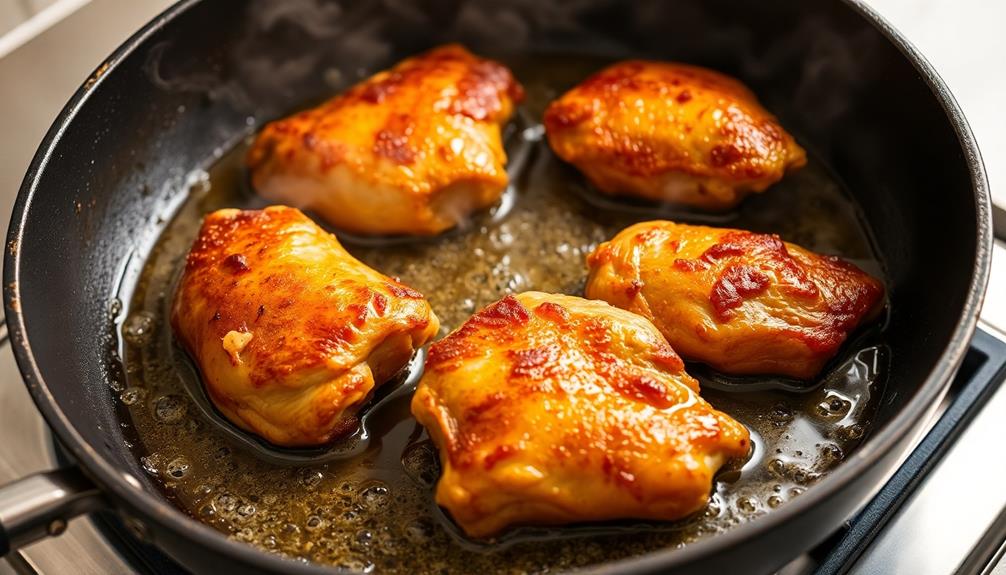
After seasoning the chicken, heat a large skillet or Dutch oven over medium-high heat.
Once the pan is nice and hot, you'll want to add a bit of oil – just enough to lightly coat the bottom.
Now, carefully place the chicken skin-side down into the pan. You'll hear that satisfying sizzle as the chicken hits the hot surface!
Let the chicken sear for about 4-5 minutes, until the skin is golden and crispy.
Don't be tempted to move it around – just let it do its thing.
Once the first side is nicely browned, use some tongs to flip the chicken over and sear the other side for another 3-4 minutes.
The goal is to get a beautiful, even sear on both sides of the chicken.
This won't only make the skin extra crispy, but it'll also help seal in all those delicious juices.
Keep an eye on the chicken, adjusting the heat as needed, until both sides are perfectly browned.
Step 3. Add Chopped Ginger

Once the chicken has been seared on both sides, you'll want to add a generous amount of chopped ginger to the pan. The fragrant, spicy-sweet ginger will infuse the chicken with its bold, tantalizing flavor.
Chop the ginger into thin slices or small matchsticks, so it can quickly release its essence into the dish. As the ginger hits the hot pan, you'll hear it sizzle and smell its aroma fill the air.
Stir the ginger around, letting it cook for about a minute until it becomes fragrant. This short cooking time will preserve the ginger's bright, vibrant flavor, without making it overpowering.
The ginger's warmth and zing will complement the savory chicken beautifully, creating a harmonious blend of tastes and textures.
Get ready for your kitchen to be filled with the mouthwatering scents of this Vietnamese classic!
Step 4. Add Soy Sauce and Chicken Broth
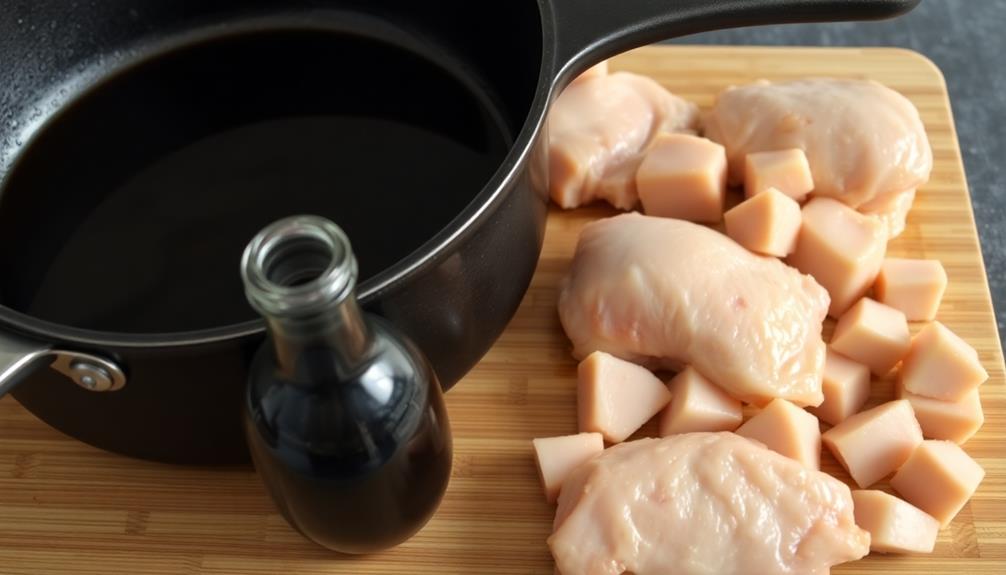
With the fragrant ginger now sizzling in the pan, you'll want to add a splash of soy sauce and some chicken broth. The soy sauce will lend a delightful umami flavor, while the broth will help create a mouthwatering sauce to coat the chicken.
Carefully pour in about 1/4 cup of soy sauce and 1 cup of chicken broth. Stir everything together, making sure to scrape up any browned bits from the bottom of the pan. This will infuse the dish with even more flavor.
Now, let the mixture come to a gentle simmer. As it bubbles away, the soy sauce and broth will meld together, creating a rich, savory base for your Vietnamese braised chicken.
The chicken will slowly braise, absorbing all those incredible flavors. Get ready for your kitchen to be filled with the most tantalizing aromas!
Step 5. Simmer Until Chicken Is Tender
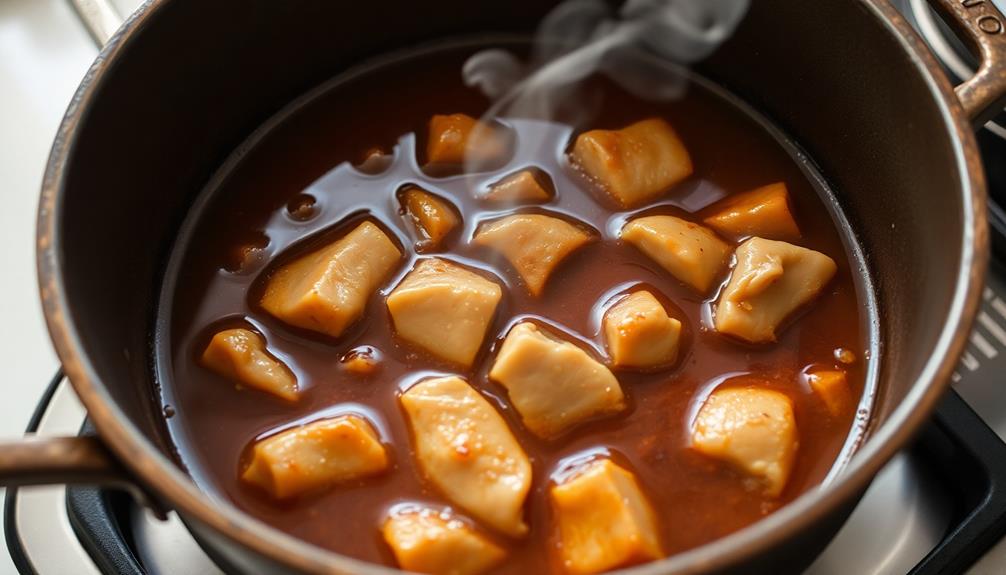
Let the chicken simmer gently in the aromatic broth until it becomes meltingly tender, about 30 to 40 minutes.
Keep the heat at a gentle simmer – you don't want the liquid to boil vigorously, which could toughen the meat. As the chicken cooks, the flavors of the ginger, garlic, and spices will infuse the meat, making it incredibly flavorful.
Periodically, use a spoon to baste the chicken with the flavorful sauce. This will help the meat stay moist and absorb all the wonderful tastes.
When the chicken is fork-tender and the sauce has thickened nicely, it's ready to serve. The meat should practically fall off the bone at this point.
Serve the Vietnamese braised chicken over steamed rice or noodles, and don't forget to spoon plenty of that rich, gingery sauce over the top. Enjoy this comforting and delicious dish with your family!
Final Thoughts
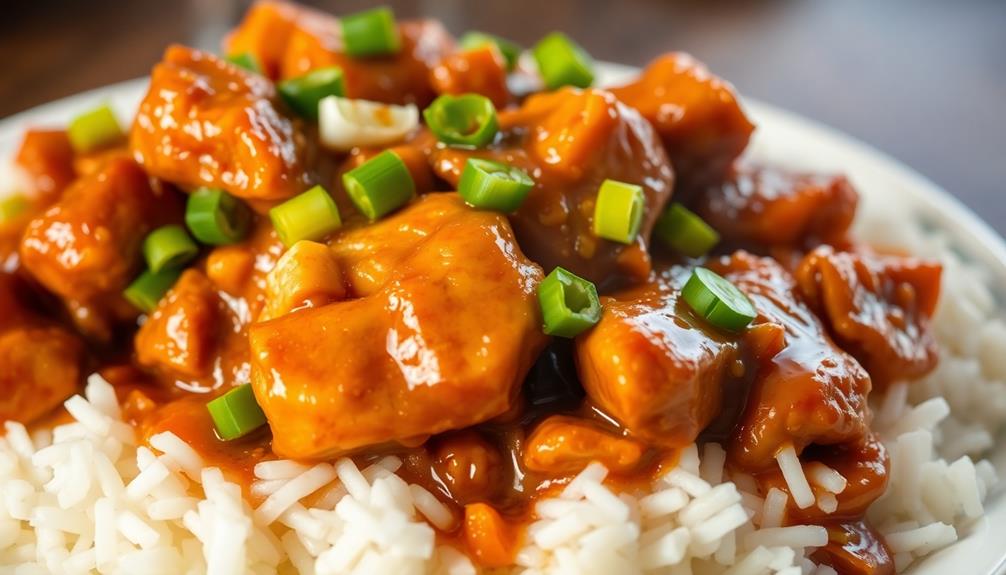
This Vietnamese braised chicken dish is a delightful fusion of flavors that's sure to impress. The tender chicken, infused with the warm, earthy notes of ginger, creates a comforting and satisfying meal.
The simmering process allows the ingredients to meld together, resulting in a depth of flavor that's both complex and harmonious.
What's great about this recipe is its versatility. Serve it over steaming white rice for a classic pairing, or try it with fragrant jasmine rice for an extra special touch.
You can also experiment with different vegetable sides, such as sautéed bok choy or a fresh, crunchy salad, to complement the braised chicken.
Whether you're hosting a family gathering or simply looking for a delicious weeknight dinner, this Vietnamese braised chicken with ginger is sure to become a new favorite.
Enjoy the vibrant flavors and the comforting warmth of this dish.
Frequently Asked Questions
What Is the Origin of the Name "Ga Kho Gung"?
Well, the name "ga kho gung" originates from the Vietnamese language. Ga means "chicken," kho means "braised," and gung means "ginger." So, the name simply describes the key ingredients and cooking method of this Vietnamese dish.
How Can I Adjust the Spiciness of the Dish?
To adjust the spiciness of the dish, you can add more or less chili peppers, chili paste, or hot sauce to suit your desired level of heat. Be mindful of your personal tolerance and adjust accordingly.
Can I Use Different Types of Chicken in This Recipe?
You can certainly use different types of chicken in this recipe. Chicken thighs, drumsticks, or a mix of both would work well, adjusting the cooking time as needed. The flavor profiles should complement the other ingredients nicely.
How Long Does the Braised Chicken Keep in the Refrigerator?
The braised chicken should keep in the refrigerator for 3-4 days. Be sure to store it in an airtight container and reheat it thoroughly before serving. Enjoy your delicious leftovers!
Are There Any Vegetarian Alternatives to This Recipe?
To make a vegetarian alternative, you could substitute the chicken with firm tofu or mushrooms. Braise them in the same savory sauce, and you'll have a delicious meatless version of this dish.
